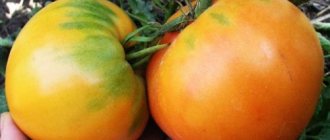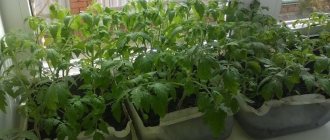The Orange Heart tomato is a hybrid of the famous Bull Heart variety, bred at the beginning of this century in Russia. The variety was originally created for cultivation in the Urals and Siberia. It was included in the State Register in 2003. A characteristic feature of this tomato is its orange fruits. The hybrid can be grown in almost all regions, and both cultivation in greenhouses and in open ground is practiced. The article discusses the description of the Orange Heart tomato variety, its photos and reviews of gardeners who grew it.
Description of tomato
The Orange Heart variety is a tall variety. The height of the stem can reach 2 m when grown in greenhouses and about 1.5 m when the variety is cultivated in open ground. The stem is liana-shaped, about 8 mm thick. This means that the Orange Heart tomato requires tying the stem to a support or trellis. The color of the stem is light green. A view of a young tomato bush Orange Heart is shown in the following photo.
This tomato variety is indeterminate, that is, its growth continues after the formation of the first ovary. Stepchildren are formed actively and frequently. Typically, 2-stem cultivation is used.
The Orange Heart tomato bush is quite large, its foliage is high. This is one of the main differences from its ancestor plant, Oxheart, most varieties of which have weak foliage. Moreover, the leaves are medium in size, have a low degree of dissection and are dark green in color.
The flowers of the tomato hybrid are small in size and light yellow in color. Usually, they are collected in simple racemose inflorescences.
The ripening time for tomatoes in greenhouse conditions is about 100 days, in open ground – about 125 days.
Description of fruits
Consider the description of the Orange Heart tomato fruit. The fruits have a characteristic elongated shape (heart-shaped, which, in fact, is reflected in the name of the variety) with smoothed ribs. The fruit ends with a small rounded point, for which the variety received the unofficial name Liskin Nose.
The weight of the fruit can vary significantly. On one bush there can be fruits weighing from 120 to 300 g, with earlier species having a larger mass.
Tomatoes have a characteristic orange color. In a state of technical ripeness (which occurs on the 90th day from the moment of emergence), they have a small green spot in the area where the stalk is attached. By the time it is fully ripe, it disappears, in addition, the color of the tomatoes becomes deep orange.
The pulp of tomatoes is extremely juicy and meaty. Ripe tomatoes contain increased levels of sugars and pectins. There is a high concentration of B vitamins and antioxidants.
The taste is considered very good, with a subtle fruity aroma. The taste rating is 4.8 on a 5-point scale, which is one of the highest.
Characteristics of tomato
This tomato variety has a very good set of characteristics. We can say that it is one of the most successful hybrids created over the past 20 years. The combination of excellent taste properties of fruits and average ripening times are very attractive to many gardeners.
Productivity and fruiting
If agricultural practices are followed correctly, the Orange Heart tomato can produce abundant harvests. In open ground, the yield is up to 2 kg per bush, when grown in greenhouses - more than 4 kg per bush. Planting both in open ground and in greenhouses is recommended in 2 rows with a distance between plants of 50 cm, and between rows of 40 cm. At the same time, given the high foliage of the plant and the large size of the bushes, it is not recommended to plant more than 2-3 plants per 1 sq. . m. Thus, the yield, depending on the method of cultivation and planting density, can range from 4 to 12 kg per square meter. m area.
These are ideal indicators; in reality, the results are a little more modest. According to reviews from gardeners, the yield of Orange Heart tomatoes is about 8-10 kg per 1 sq. m area; The typical appearance and size of the fruit is shown in the photo below.
The ripening time in the greenhouse is about 3 months. Officially, the time is 90-95 days, however, technical ripeness occurs approximately a week and a half before complete ripeness. In open ground they are extended for another 1 month (from 120 to 135 days).
The main factor affecting yield is the way the plant is grown. When using single-stem agricultural technology, the yield will be low: it is unlikely that you will be able to remove more than 2 kg from a bush during greenhouse cultivation. Growing an Orange Heart tomato with 3 stems is quite problematic technically, given the high density of the bush.
Therefore, double-stem cultivation is used. It is this that allows you to maintain a balance in the number of bushes per unit area and ensure maximum yield per 1 square meter. m.
Area of application of fruits
The fruits of the Orange Heart tomato variety are used mainly fresh. They are used to prepare first and second courses, in particular, hot and cold soups, side dishes, and sauces. In salads, thanks to its excellent taste, this variety has virtually no equal. Tomatoes have proven themselves very well in making juice.
Due to the absence of red coloring pigment, which is a strong allergen, orange tomatoes are considered an almost hypoallergenic product and are recommended for baby food.
Due to its dense structure and fairly durable skin, the fruits of this tomato variety have good keeping quality and transportability.
However, this variety is practically not suitable for preservation. Prolonged heat treatment and stay in the marinade significantly worsen the consistency of the pulp and its taste: it becomes fibrous and sour.
Resistance to diseases and pests
The Orange Heart tomato is highly resistant to the following diseases:
- late blight;
- bacteriosis;
- hide the rot;
- mosaic.
However, we should not forget about preventive measures that have approximately the same sequence of actions for most tomato diseases.
It should also be noted that the Orange Heart tomato has relatively good resistance to aphids and mites.
Advantages and disadvantages of the variety
Summarizing the description and characteristics of the Orange Heart tomato variety, we can say that it has the following advantages:
- excellent taste;
- increased content of useful elements in the pulp;
- absence of allergens;
- high productivity;
- unpretentiousness in cultivation - the variety is recommended for cultivation in a wide variety of climatic conditions;
- good resistance to major tomato diseases and pests;
- high shelf life and transportability.
The disadvantages of the variety are:
- relative difficulty in forming a bush due to active pinching;
- the impossibility of obtaining your own seed, since the variety is actually a hybrid.
Important!
The variety is capable of producing seeds. These seeds are capable of bearing fruit, but the quality of the material will leave much to be desired. Tomatoes obtained from such plants will be small, tasteless and have a wide variety of colors and shapes.
Main advantages of the variety
The characteristics of these tomatoes should begin with the fact that they can be eaten by allergy sufferers and that is why they are recommended as the first in the diet of young children. But besides this original shape and color, the fruits have juicy pulp with a pleasant taste and a light fruity aroma. There are few seeds inside, which is also an undeniable advantage when eaten.
They belong to the salad category, but, judging by the reviews of gardeners who have already tried tomatoes, it is most optimal to use them for preparing sauces and juices that will have a thick consistency and a sweetish taste with a pleasant aroma.
It should also be noted that they are resistant to most diseases and unpretentious in cultivation, however, there are no ideal varieties and all have disadvantages. In “Orange Heart”, this is the need to form a bush and immunity to certain fertilizing.
Growing rules
Growing Orange Heart tomatoes is almost exactly the same as growing any other variety, but there are some nuances. In particular, this concerns the issues of forming a bush and maintaining it in the required shape. However, this is typical for many indeterminate varieties of tomatoes.
Important! To obtain a good harvest from plants that have a high tasting rating, correct crop rotation is required.
Good predecessors of the Orange Heart tomato are representatives of cruciferous vegetables, as well as cucumbers, herbs and carrots. It is highly undesirable to plant tomatoes after any nightshade crops (potatoes, other tomatoes) or legumes.
Planting seedlings
Taking into account the timing of fruiting, planting of Orange Heart tomato seedlings should be done at the end of February or at the beginning of March when grown in greenhouses. The planting dates are shifted 2-3 weeks later if you plan to plant the Orange Heart tomato in open ground.
For normal development of the Orange Heart tomato, it should be planted in open ground approximately two months after planting. It is highly undesirable to keep seedlings in pots. On the other hand, it is necessary that the temperature of the top layer of soil is not lower than + 18 °C. Therefore, when choosing the timing of planting seedlings, you should take into account the features of the local climate and adjust the time of planting seeds taking into account these features.
Preparing for planting seeds involves standard procedures, not much different from other varieties of tomatoes.
For soil, you can choose a ready-made mixture for seedlings or make it yourself from a mixture of garden soil and peat, which are taken in a ratio of 50% to 50%. Sometimes the mixture may consist of 3 components mixed in equal proportions: soil, peat and sand. As such, the composition for seedlings does not play a role in this case, since when growing the Orange Heart tomato variety, fertilizing will be used.
Before planting, the soil can be disinfected using a solution of potassium permanganate, or by calcining it for half an hour in the oven at a temperature of + 100-110 ° C. In the latter case, the soil needs to sit under a layer of gauze for 1 to 2 weeks to restore the microflora.
It is also advisable to treat the seeds immediately before planting with an antiseptic, which can be the same potassium permanganate or copper sulfate solution (concentration 0.1-0.2% and 1%, respectively). The seeds are immersed in the solution for 3-5 minutes, after which they must be dried and only then planted. You can speed up the seed drying process using a regular hairdryer, without raising the temperature of the warm air above + 40 °C.
For containers, you should take several dozen individual pots (peat or plastic) with a diameter of at least 8 cm, since the seedlings can be quite spreading. It is not advisable to use one large box for seedlings, so as not to injure the root system of the plant during replanting. In addition, such planting allows plants to be individually transferred to different conditions to ensure their uniform growth and saves the gardener from such a tedious process as picking.
The pots are filled with 80% soil, a 1.5-2 cm depression is made in the center of the pot, 1-2 seeds are placed in it, sprinkled with soil and watered.
After watering, the seedlings are covered with plastic film or glass and sent to a warm place without lighting. In about a week the seeds will sprout; at the same time, remove the film from the seedlings and place the pots on the windowsill of the south window, since Orange Heart tomatoes need a lot of light. In mid-spring, the sun may not be enough; seedlings should be additionally illuminated with fluorescent lamps for 3-5 hours a day.
Caring for seedlings includes daily watering with warm water. To prevent plants from being washed out of the soil, it is best to water with a spray bottle.
Picking seedlings is done a month after planting. In the case of growing in an individual container, instead of picking, the weaker plant of the two planted will be pinched.
After this, the first fertilizing of the seedlings should be made in the form of a special complex fertilizer for young plants, which contains an increased concentration of nitrogen fertilizers to improve the growth of green mass.
The second feeding is carried out approximately 10 days before planting the Orange Heart tomato in the greenhouse/open ground (at the beginning or end of May, respectively). However, phosphorus-potassium fertilizers, necessary to strengthen the root system, should prevail in it.
Tomato transplant
Transplantation into a greenhouse or open ground is carried out 60-65 days from the moment the first shoots peck (mid or late May, respectively). This procedure for Orange Heart is also not much different from other tomatoes. Varietal differences lie only in the recommended planting pattern.
For the Orange Heart variety, the planting pattern is 50 cm between bushes and 40 cm between rows when grown in greenhouses and 60 cm/50 cm when planted in open ground. Both in greenhouses and in open ground, two-row cultivation of tomatoes is mainly used.
Important! The distance between the beds should be 80 cm or more, since each bush must be provided with free access to be able to form and tie it up.
The depth of the holes for transplanting the Orange Heart tomato is 15 cm. Approximately half of them should be sprinkled with organic fertilizer - rotted manure or compost. Next, a young plant with a lump of earth is placed in the hole, the hole is filled with soil, lightly compacted and watered with 3-5 liters of water.
Important! It is advisable to transplant plants to a permanent place in the garden or greenhouse in cloudy weather or in the evening.
Subsequent care for tomatoes
Subsequent care for tomatoes is standard and includes watering, fertilizing, loosening the soil and forming a plant bush. All procedures, except the last one, are the same for any other variety of tomatoes:
- Watering is carried out once every 3-4 days with warm, settled water. It should be carried out directly under the root, without wetting the leaves.
- After each watering, you should loosen the soil to a depth of 2-3 cm. If mulch is used, this is not necessary.
- Adult plants should be fed 3-4 times during the season. It is recommended to alternate between root and foliar feeding. It is recommended to stop the latter after the first green fruits appear. It is best to use complex fertilizers, each time closer to maturity, using formulations with less nitrogen.
As for the formation of the bush, the Orange Heart variety has some features. A tomato produces the greatest yields when it is formed into two stems. This means that when forming an Orange Heart bush, you should remove all the lower leaves and all the stepsons, leaving only one of them, located under the first flower cluster.
Liana-like stems of great length (1.5-2.0 m, depending on growing conditions) require garters at several points to supports or trellises. It is also advisable to tie up large bunches of fruit.
Tips for farmers
Growing orange tomatoes is not at all difficult if you know exactly how to do it correctly. And the cultivation technology for the proposed variety is as follows:
- At the end of February or mid-March (for greenhouses and open ground, respectively), sow tomato seeds for seedlings, having previously treated them with disinfectants and growth stimulants.
- Seeds can be sown in a common container or individual pots. It is necessary to deepen the grains by 1-1.5 cm.
- It is recommended to water the seedlings with a spray bottle so as not to wash out the embedded seeds.
- With the appearance of 2 true leaves, young plants, if necessary, are planted in separate containers.
- 1-2 weeks after picking, the seedlings need to be fed with organic matter or complex fertilizer with a high nitrogen content.
- At the age of 60-65 days, tomato seedlings can be planted in the ground, but before that you need to feed the plants with potassium and phosphorus for the development of the root system.
- To plant tomatoes in a garden bed you need 2-3 bushes for every 1 m2 of soil.
- 2 weeks after planting, the tomatoes need to be fed again.
- At the active growth stage, form plants into 2 stems.
The growing rules given are quite simple. They also work when cultivating not only this variety, but also all other indeterminate tomatoes with an average period of fruit ripening. It is worth remembering that orange tomatoes actively respond to fertilizing, and excessive amounts of fertilizer can harm the plants. In order not to cause harm to tomatoes, you need to monitor their condition and signals about a deficiency (excess) of a particular substance.
Pest and disease control
Despite the plant’s high resistance to major tomato diseases, preventive measures will not be superfluous. The main problems of all nightshades are fungal diseases and invasions of insects specializing in this family (Colorado beetles, wireworms, aphids, etc.). It is on the prevention of these problems that you should focus when growing Orange Heart tomatoes.
Preventive measures include regular ventilation of the greenhouse, treating the soil with preparations containing copper (for example, Bordeaux mixture or copper sulfate), moderate watering without stagnating moisture, etc.
Mulching with freshly cut grass will help protect the plant from about half of potential pests; If you cover the free soil with agrofibre, then the likelihood of a plant being attacked by a wireworm or Colorado potato beetle is reduced to almost zero.
You can fight aphids with a warm soapy solution, and slugs with a 10% ammonia solution.









